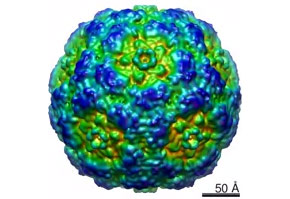

Goal is to understand the significance of the presence of this emerging virus, which is found in half of children with tonsillar hypertrophy
Goal is to understand the significance of the presence of this emerging virus, which is found in half of children with tonsillar hypertrophy.
Goal is to understand the significance of the presence of this emerging virus, which is found in half of children with tonsillar hypertrophy.

Goal is to understand the significance of the presence of this emerging virus, which is found in half of children with tonsillar hypertrophy
By Frances Jones
Agência FAPESP – A group of researchers at the Universidade de São Paulo’s Ribeirão Preto Medical School (FRMP-USP), which specializes in emerging viruses such as hantavirus, West Nile and Oropouche, is eyeing a likely very old virus that was only discovered in 2005.
The human bocavirus – a distant relative of canine parvovirus – was found in approximately 5% of more than 1,000 samples analyzed by the school’s Virology Research Center, which were collected from children treated in emergency rooms or admitted to FMRP’s Hospital.
The number is similar to that obtained at many other locations around the world, including Sweden, where the virus was discovered in a metagenomic study that investigated respiratory samples from people with respiratory infections who had negative results for conventional viruses.
“The human bocavirus is from a known family that includes several human viruses, the B-19 parvovirus and the canine parvovirus. Before 2005, the human bocavirus had never been detected,” commented Professor Eurico de Arruda Neto, one of the main researchers on a FAPESP-funded Thematic Project on the subject.
According to Arruda Neto, although parvoviruses have been found in the human species for some time, bocaviruses are considered emerging viruses because they were only recently discovered. In general, the bocavirus causes mild respiratory infections and can induce bronchiolitis in very small children.
As part of the thematic project, the researchers are seeking to discover whether the bocavirus was detected in infected children because of persistent infection or an acute infection at the time of treatment.
“We developed a method in which, instead of looking for the DNA of a virus, we sought messenger RNA for capsid proteins, the presence of which is a replication marker,” explained Arruda Neto. According to him, if messenger RNA is being produced for the structural protein, the virus is replicating. In other words, there is an acute infection.
“After this test, we discovered that 25% of patients who are positive for the DNA of this virus have messenger RNA. Thus, approximately one-fourth of the children with the bocavirus are, in fact, in the acute phase of infection by this agent. Others probably have a persistent form as a result of past infections,” he said.
The researchers also found that the bocavirus is almost never alone, as there is a very high rate of co-infection. “We found several viruses in these samples: not only one or two, but often four or five different agents. In the laboratory, we are very intensely investigating the importance of these co-infections,” said Arruda Neto.
Only 5% of the children with the virus had acute infections, but the percentage of those infected increased when tissue from tonsils and adenoids that had been surgically removed from these children due to hypertrophy were analyzed. In these cases, the number of children infected by the bocavirus surpassed half of the sample, intriguing researchers.
“What are they [the bocaviruses] doing in tonsils and adenoids? The child does not have symptoms of an acute infection, is not sneezing or coughing. The tissue was removed because it had hypertrophied, and we then found a virus inside the tonsil tissues,” stated Arruda Neto.
“What does this mean? Is the presence of the virus beneficial or malevolent? Is it related to the tonsillar hypertrophy found in so many children? We still don’t have answers to these questions, which are being investigated in another FAPESP Thematic Project that we are part of, coordinated by Wilma Terezinha Anselmo Lima of the Otolaryngology Department at FMRP-USP,” said Arruda Neto.
Ancestry
The Ribeirão Preto Group did complete genome sequencing of the bocavirus in 20 patients, revealing low variability. “What is interesting is that although bocavirus infection is rarely serious, it is persistent. Other researchers have shown that there are fragments of parvovirus DNA incorporated into the human genome from thousands of years ago,” said Arruda Neto.
“Exactly what the bocaviruses represent in terms of current cases of disease and what it means to find them in the throat of a child is what we are investigating now,” he said. An article, including data from the study on children in Ribeirão Preto that was coordinated by Arruda Neto, was published in PLOS One and can be read at: www.plosone.org/article/info:doi/10.1371/journal.pone.0021083
Republish
The Agency FAPESP licenses news via Creative Commons (CC-BY-NC-ND) so that they can be republished free of charge and in a simple way by other digital or printed vehicles. Agência FAPESP must be credited as the source of the content being republished and the name of the reporter (if any) must be attributed. Using the HMTL button below allows compliance with these rules, detailed in Digital Republishing Policy FAPESP.





